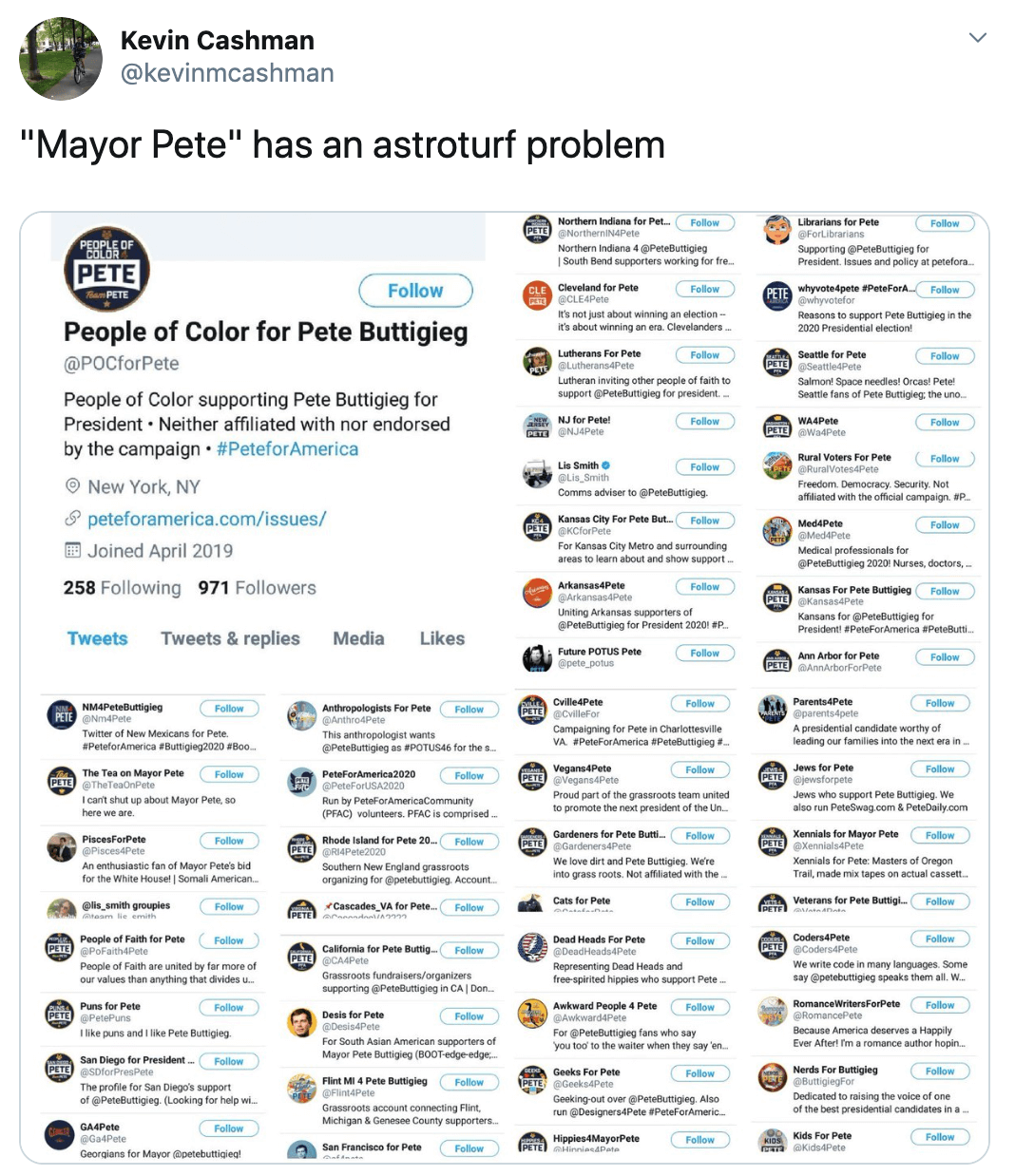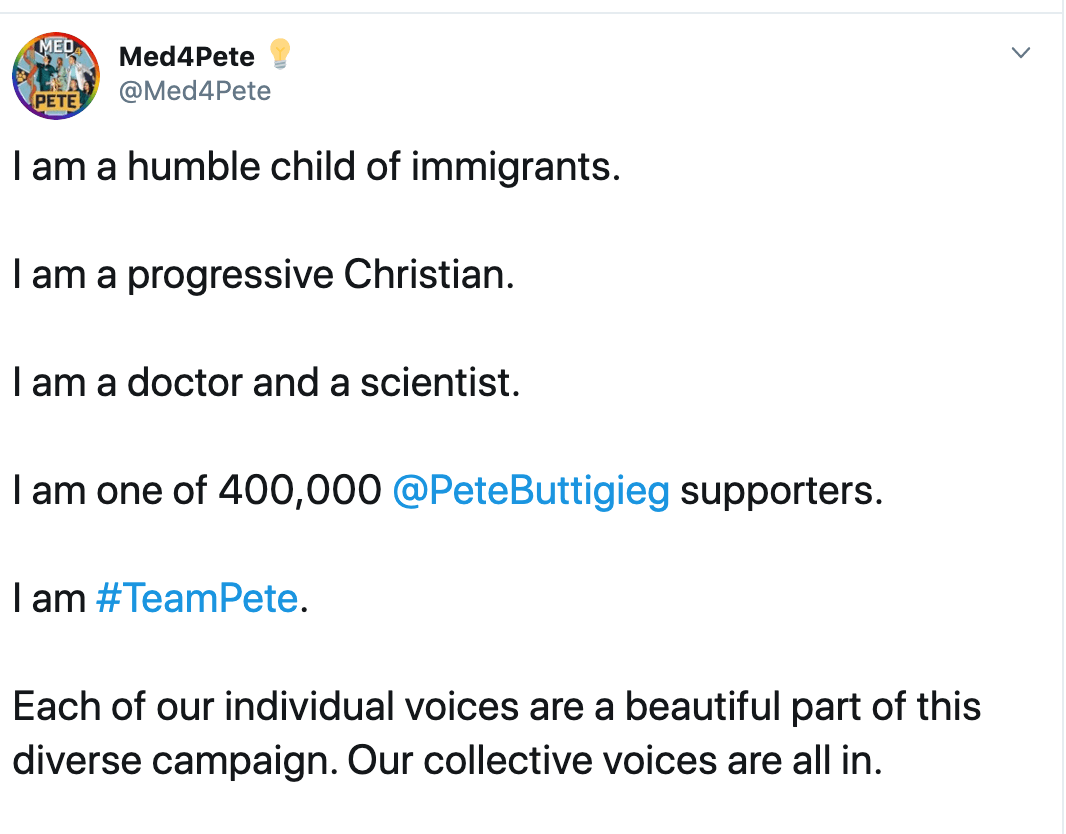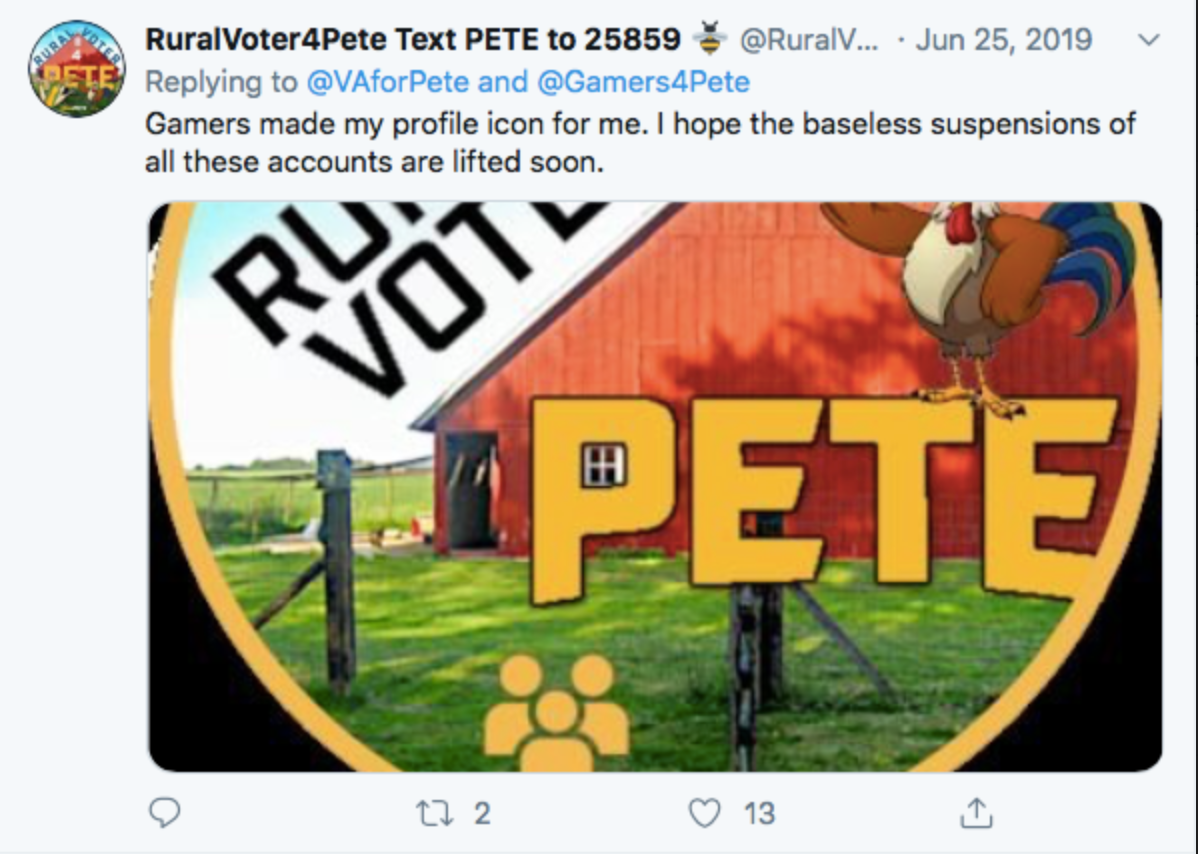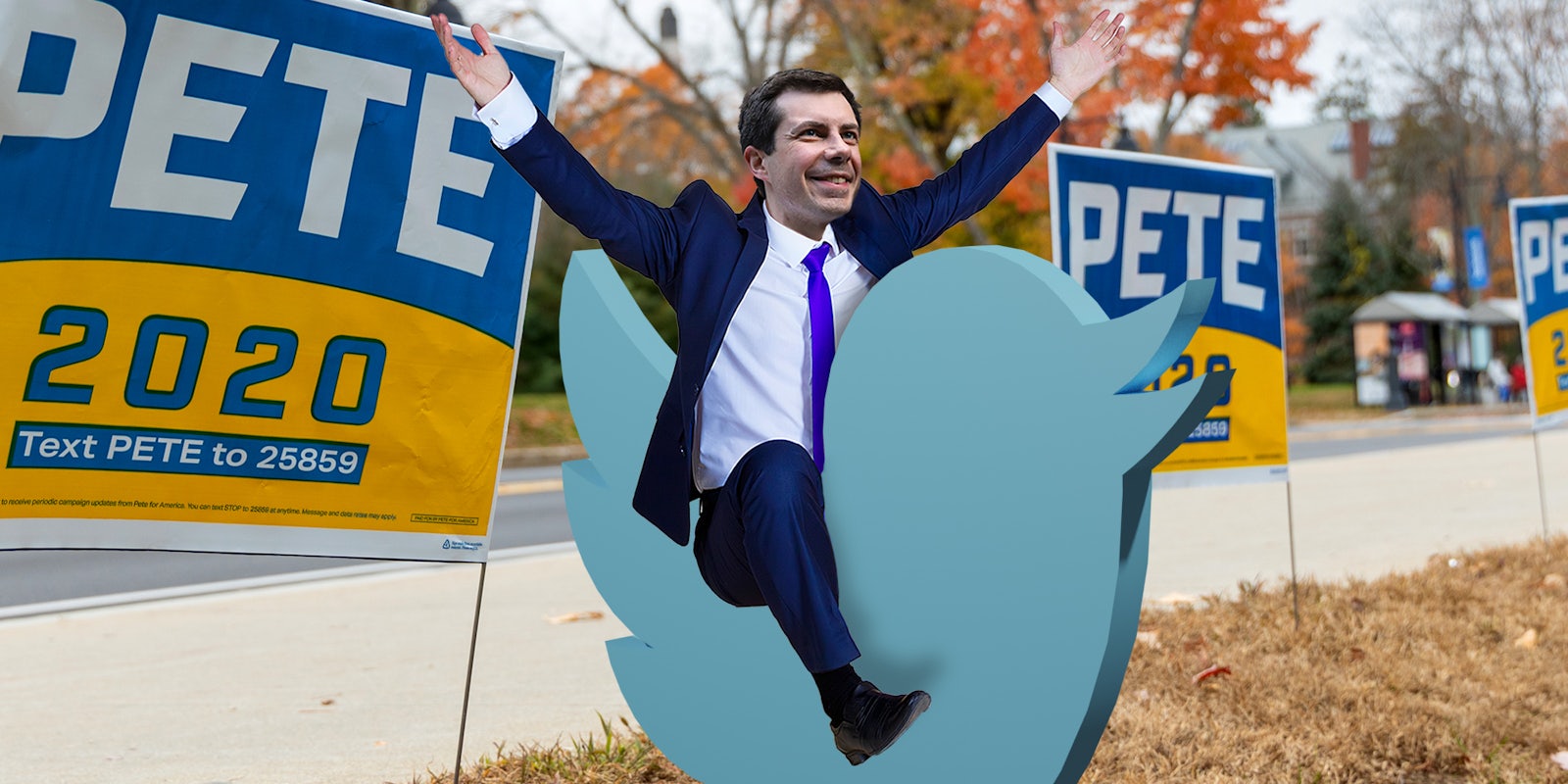It started with a CNN town hall in March. Thirty-seven-year-old South Bend, Indiana Mayor Pete Buttigieg told CNN’s Jake Tapper to call him “Mayor Pete,” then proceeded to charm audiences by leveling calm, measured insults at Vice President Mike Pence.
“At least he believes in our institutions, and he’s not personally corrupt,” Buttigieg started, “But how could he allow himself to become the cheerleader of the porn star presidency? Is it that he stopped believing in scripture when he started believing in Donald Trump?”
The town hall was a watershed moment for Buttigieg, whose campaign sent a fundraising email blast 20 minutes later. The little-known presidential candidate, then polling at 1% in Iowa and New Hampshire, was on course to becoming a household name.
That’s when the Twitter accounts started popping up.
There was Librarians for Pete, Grandmas for Pete, and Anthropologists for Pete, @Crafters4Pete, and @Readers4Pete, @Introverts4Pete and People of Faith for Pete.
Don’t forget @Gardeners4Pete, which joined Twitter in April, and Artificial Intelligence for Pete, which joined in May, along with Avocado Toast for Pete and @Med4Pete, which aimed to show the support of medical professionals. Pinoys for Pete joined Twitter a month after People of Color for Pete, along with Asians, Hippies, and Awkward People for Pete. This is not to mention the various state and city “4Pete” accounts, like Seattle, Virginia, Kansas City, and Hawaii.
Many of these accounts resembled each other, with logos and fonts mirroring the official Buttigieg campaign. They retweeted similar pro-Buttigieg content and were indomitably upbeat. They had to be bots. Or at the very least, paid “supporters.”
Twitter users started calling them out accordingly. “You’re late for the cult meeting,” wrote @Chrislongview on May 12 in response to @RuralVoter4Pete, who’d retweeted an analysis of a speech Buttigieg gave in Las Vegas. Another Twitter user responded, “I wonder how much they get paid with ‘4Pete’ in their account name.” @Arkansas4Pete popped up unsettlingly quickly with a Buttigieg GIF: “We get paid handsomely in the form of hope for our future!” she wrote.
By June 24, some users started to report the suspicious 4Pete accounts. To draw attention to the issue, Kevin Cashman, a senior associate at the Center for Economic and Policy Research, put together a tweet featuring the various 4Pete accounts with the caption: “‘Mayor Pete’ has an astroturf problem.”

Astroturfing describes a centrally organized effort to create a false impression of grassroots support, fomenting a belief that there’s way more love for a political candidate or idea than there really is.
Whether that’s happening here is up for debate.
“I think it’s a little different from astroturfing I’ve seen in the past,” Cashman told the Daily Dot this month. “It appears there is some kind of centralized promotion… very enthusiastic people were creating these groups that make it appear like there’s this large support for [Buttigieg].”
While Democratic candidates like Sen. Bernie Sanders (I-Vt.) and Andrew Yang have long boasted fervent online followings, Buttigieg hadn’t previously amassed much social media fandom. Cashman added that a July show of false support for Buttigieg—namely an open letter noting that certain Black community leaders in South Carolina endorsed his Douglass Plan for Black America—later confirmed his suspicion that the campaign was engaging in fishy practices.
Around the time of Cashman’s tweet, talk of 4Pete accounts getting banned starting circulating on Twitter.

For 4Pete account holders, this was a major problem. As Arkansas4Pete told me, “We’re just people, real people who are passionate about Pete and want to do whatever we can to promote his message.”
Arkansas4Pete is Kori Gray, a 37-year-old medical student at the University of Arkansas. “The accusations about being astroturf or being a bot army have been so frustrating,” she said. “If anybody looks at our individual accounts… I post pictures of our local events. I post pictures of when we meet up. I post screenshots of donations with my real name on them.”
I heard that same sentiment echoed across the many 4Pete Twitter account holders I spoke with in January, nearly a dozen in total. All were incredulous that people could dismiss them as fake or showing false support, when with very little digging, it’s easy to learn that Librarians for Pete, 68, is a real retired public school librarian living on a small farm in Michigan (she preferred to withhold her name).
Washington4Pete is a group with a website featuring its full team, and its Twitter admin, Aeron Terry, has met the woman who runs Pinoys4Pete out of Seattle. RuralVoter4Pete is Patrick Franklin, 43, a 2006 Democratic candidate for the Texas legislature. GenZ4Pete is an 18-year-old, whose picture Med4Pete, a 33-year-old medical professional in California, sent to me over email.
They may not be bots, but experts do have questions about the behavior.
The line between false representation and honest, eager support starts to blur.
Overall, the 4Pete phenomenon is a fascinating one, perhaps unprecedented in its mix of using official campaign-sanctioned tactics and ethical guidelines mixed with genuine grassroots origins. It appears unbelievable given that the simple fact that those with 4Pete accounts are so unified, so there to support one another, and frankly, so nice.
But there’s no central campaign entity guiding them—other than Buttigieg’s official campaign “Rules of the Road,” which dictate followers must, for example, respect others (even competitors), be honest, “favor the meaningful,” and “be joyful.”
Many 4Pete people have gotten to know one another, forging bonds both in nearby cities and across the country. Franklin made his own Twitter Direct Message group with about a dozen other Buttigieg supporters—including Med4Pete and Anthropologists for Pete—who seemed smart, interesting, and like they’d contribute to a diverse group.
“I was looking for men, women, people of color, straight people, gay people, Christians, and atheists,” Franklin said. Sometimes they chat about Buttigieg, other times they talk about their problems.
“We’re friends,” Franklin said. “We’ve come to know each other online and in many cases, care very deeply about each other.”
One of the more (modestly) viral moments for the 4Pete movement came on July 1. Med4Pete tweeted aspects of her personal identity, and it caught on. Soon numerous other 4Pete accounts, from @Kids4Pete to @NY4Pete, along with other Buttigieg supporters without 4Pete Twitter handles, were voicing their identities in connection with their positions on #TeamPete:

This sparked an @IAmTeamPete Twitter handle and website, run mostly by Anthropologists4Pete along with Franklin and another four supporters who constitute the “core group,” Franklin said. “It’s just a vehicle for amplifying the voices of others on Twitter, a way of sorting through and pushing out what we feel are positive messages.”
The 33-year-old woman who started that popular July thread as Med4Pete (she preferred we not publish her name) laughed when telling me she had no idea the tweet would start such a chain reaction. “I showed it to a few of my friends… and Anthro[pologists for Pete] I think was the first to retweet it,” she said. “After that, it went completely viral.” (Med4Pete is now operated jointly by the account’s creator, Gray, and one other medical professional.)
“I’m sitting as tweets are coming in, and I’m completely floored and stunned and inspired,” she said, recounting stories shared by Buttigieg supporters living with depression, PTSD, and children with disabilities. Others chimed in to say they were refugees, children of immigrants, wives, husbands, or “members of the religious left.”
“To show that this movement was that diverse,” said Med4Pete, “it was jaw-dropping.”
One adopted, adult woman even connected through the thread with a fellow Buttigieg supporter who happened to be a genealogist, Jessica Senkyr. The adopted woman had taken a DNA test on Ancestry.com. “I used those results along with traditional genealogy to figure out who her biological parents were,” Senkyr wrote to me in an email. “She was also able to see photos of half-siblings that she’d never seen before.” The woman still messages Senkyr about new ancestors she’s discovering.
In spite of these organic human moments, those outside of the 4Pete movement remained incredulous. “People just think…” Med4Pete said, pausing. “I think they can’t possibly believe that a movement like this is real.”
. . .
Besides the lack of previously perceived organic enthusiasm for Buttigieg, one aspect of the 4Pete movement that makes it appear so bot-like is the accounts’ uniform design.
These designs, it turns out, come from the official Pete for America campaign.
Buttigieg’s campaign offers a design toolkit that anyone who wants can use to show support for the Democratic candidate.
“We provided the campaign’s colors and fonts at launch through a digital design toolkit. Many campaigns keep that information close, but very early on we encouraged people to use the campaign’s graphics and design to spread Pete’s message,” says Tess Whittlesey, an official campaign spokesperson. “It creates buy-in and supporters feel more directly a part of the movement behind Pete.”
And one account, @Gamers4Pete, started making headers and avatars.

Whittlesey said she thinks sharing the official campaign’s design has “helped Pete grow from an unknown to a top-tier candidate.”
The strategy gives the official Buttigieg campaign a decidedly millennial aspect, in keeping with the candidate’s age. The campaign even created an “online engagement director” position, held by Stefan Smith, who organizes support efforts for Buttigieg online. Part of his job is getting people to train and volunteer as “digital captains,” who can help spread Buttigieg’s message across social media. As of Jan. 28, the campaign reports that more than 800 people have taken on the role. Of those, about 80 have “X4Pete” Twitter handles.
One could call it crowdsourced campaigning. As Librarians for Pete pointed out, “For a person who has been a Democrat for a long time, this campaign is totally different. It’s very much a fusion of regular grassroots people and the staff.” Her daughter, 40, sees the campaign as “a new millennial approach,” said Librarians. The campaign staffers, she added, “don’t feel this sense of ownership over the campaign that traditional candidates did.”
The question remains, though, whether being real individuals operating 4Pete accounts is mutually exclusive with being part of an astroturfing campaign.
Librarians for Pete is an account run by one former librarian, not several. That’s misleading to people who see the account and assume it’s run by a group of librarians who support Buttigieg, and could be construed as astroturfing.
That said, the plural name of the account ended up becoming a self-fulfilling prophecy. “Quite a lot of librarians follow me,” the account holder said, and she’s communicated with many of them, fostering a sort of mini online community of librarians for Buttigieg.
There are also people with more than one 4Pete Twitter handle, like Gray operating Arkansas4Pete and contributing to Med4Pete. And Anthropologists for Pete (her solo account) also operates the Gamers4Pete account with several others.
“If the accounts amplify the same messages/tweets together, I believe this constitutes astroturfing,” said Pik-Mai Hui, a student at the Indiana University School of Informatics, Computing, and Engineering. Hui brought up the example of one person who controls three accounts that retweet the same message at the same time. That looks like three people, each retweeting once, as opposed to one person retweeting three times, which Hui said, “creates an illusion of a population that is larger than the real population.”
The way this is happening among 4Pete accounts, however, doesn’t constitute astroturf-level scale or uniformity. Though the 4Pete accounts retweet similar content, they’re not all retweeting the exact same tweets at the exact same time.
Corey Goldstone, communications manager at the Campaign Legal Center, a nonprofit focused on the accountability of politicians and candidates said to the Daily Dot, “If a campaign operative is distributing social media graphics to volunteers running [a 4Pete account], and they are tweeting out content organically, that would be a normal campaign practice.”
He added, “Twitter has just been cracking down on the practice of bulk automation of identical or substantially similar tweets.”
Of course, many people have multiple Twitter accounts. Someone might have an account for their YouTube channel where they announce their latest unboxing video, another account where they post about their day job at a nonprofit, and yet another where they post updates about their dog. Hui said that clearly identifying such accounts as belonging to one person means they don’t constitute astroturfing, and “wouldn’t retweet the same tweet together,” anyway.
But what if the owner of all three accounts has a really strong political opinion, and retweet the same political tweet from all three accounts? Then the line between false representation and honest, eager support starts to blur.
Ultimately, Filippo Menczer, an expert in analyzing the spread of misinformation on social networks under whom Hui studies, doesn’t see the 4Pete movement as an astroturf campaign. They’re not posting content Buttigieg or his campaign tell them to post, and the Rules of Road guidelines look to Menczer more like “rules of civilized conversation” than a top-down approach to social media strategy. “I would not label that astroturf, personally,” he said, calling the behavior seemingly “innocuous” before adding, “There is no clear line.”
Clearer examples of astroturfing have come out of the Democratic primary race.
Menczer’s team found some through a tool they’d been developing called BotSlayer, an application that tracks and aggregates tweets with matching keywords and subject matter to determine whether the information is being spread by bots or otherwise suspicious networks.
Menczer remembers one debate when Sen. Kamala Harris (D-Calif.) was still in the running in which she “attacked Biden” and got a bump in the polls. “After that, we saw a lot of messages [compiled by] BotSlayer claiming she was not eligible to be president,” Menczer said. The claims that she was not eligible were quickly debunked.
Another bot-driven example of astroturfing Menczer and Hui analyzed recently involved President Trump. In December, Trump retweeted a post that named the alleged Ukraine whistleblower whose complaints led to the president’s impeachment. The original post came from “Surfermom77,” who had “displayed some hallmarks of a Twitter bot,” CNBC reported. The account tweeted 72 times a day on average and cycled through several stock photos for its avatar.
After the account disappeared and then resurfaced with a changed name, Hui did background analysis and found the account had taken on “a bunch of different personas with different names at different times.” This behavior goes against Twitter’s terms of service because it constitutes “impersonation,” according to Menczer.
However, Twitter’s policy is also against taking down tweets by Trump, which includes anything the president has retweeted to his timeline.
This left the platform with a choice—break its anti-impersonation rule, or break its Trump rule.
“[Twitter] decided to say the account wasn’t doing anything wrong even though it was in direct violation of the terms of service,” said Menczer. In other words, the priority lay with preserving Trump’s tweets.
However, Twitter has recently been cracking down on accounts Trump retweets.
Compared to these examples, Buttigieg supporters with 4Pete Twitter handles don’t behave like bots. They may seem creepy, or too wholesome, or too coordinated, but those I spoke with retweet similar pro-Buttigieg messages because they genuinely believe them.
And they appear coordinated because they have been coordinating. Most share their favorite tweets for others to retweet, and many have gotten together to schedule and attend “Pete-ups” (meet-ups for supporters).
For instance, Aeron Terry, over at the Washington for Pete group, has been helping put together guides for “overseas and veteran voters…to make sure they know how to participate in the primary” (Washington State recently switched to a primary from a caucus). Through the Orange County for Pete Twitter handle, Med4Pete has united with other Buttigieg supporters in her area and started volunteering for the official campaign, doing text banking.
“It has nothing to do with the 4Pete accounts at all,” she said. “It’s just that we’re organizing.”
READ MORE:


